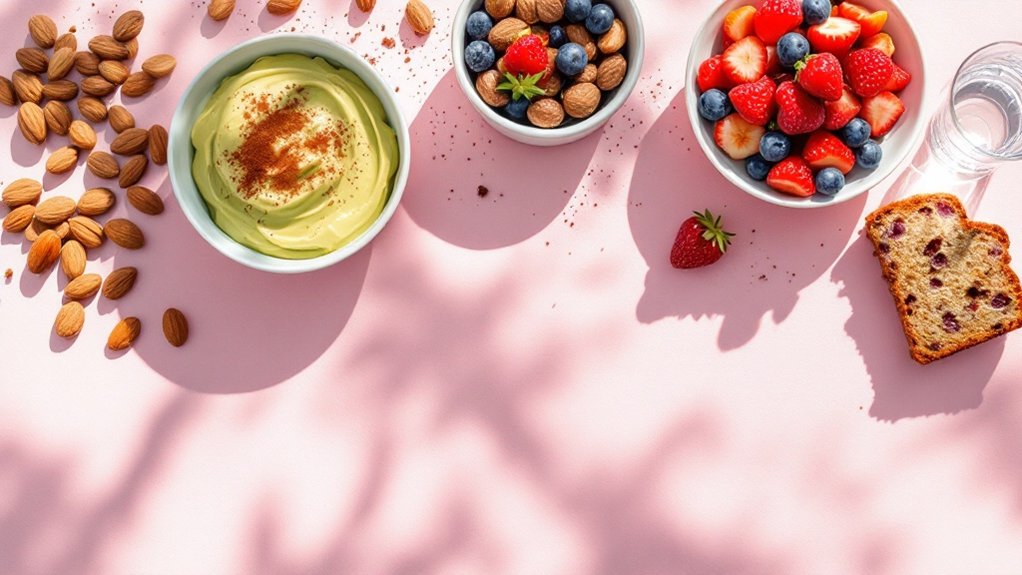Many individuals struggle with sugar cravings while trying to lose weight. These cravings can derail progress and lead to unhealthy choices. However, there are effective strategies to manage these urges. By understanding the role of macronutrients, one can make smarter selections that satisfy sweet desires without compromising weight loss goals. Exploring these alternatives reveals options that not only curb cravings but also enhance overall dietary habits. What are the best choices to contemplate?
Understanding Sugar Cravings and Their Impact on Weight Loss
Why do many individuals struggle with sugar cravings during their weight loss journey? These cravings often stem from a combination of physiological and psychological factors. When individuals reduce their caloric intake, their bodies may react by seeking quick sources of energy, typically found in sugary foods. Additionally, the brain releases dopamine in response to sugar, creating a pleasurable sensation that reinforces the desire for sweets. Emotional triggers, such as stress or boredom, can also lead to cravings, as people often turn to sugary treats for comfort. Moreover, restrictive diets may inadvertently heighten cravings, making it challenging to stick to a weight loss plan. Understanding these underlying factors is essential for developing effective strategies to manage sugar cravings while pursuing weight loss goals.
Smart Substitutes for Satisfying Your Sweet Tooth
Although sugar cravings can pose challenges during weight loss, there are numerous smart substitutes that can satisfy a sweet tooth without derailing progress. One popular option is fruit, particularly berries, which offer natural sweetness along with fiber and essential nutrients. Another alternative is using natural sweeteners like stevia or monk fruit, which provide sweetness without the calories associated with sugar. Greek yogurt with a drizzle of honey or a sprinkle of cinnamon can also serve as a satisfying treat. Dark chocolate, with its lower sugar content, can be enjoyed in moderation for those craving chocolate. Additionally, incorporating homemade energy bites made with oats and nut butter can provide a sweet yet nutritious snack. These substitutes can help manage cravings while supporting weight loss goals.
Protein-Packed Snacks to Curb Sugar Cravings
Snacking on protein-packed foods can effectively combat sugar cravings and support weight loss efforts. High-protein snacks, such as Greek yogurt, cottage cheese, or hard-boiled eggs, provide essential nutrients while promoting satiety. These foods help stabilize blood sugar levels, reducing the likelihood of reaching for sugary snacks. Additionally, incorporating nuts or seeds can offer a satisfying crunch along with healthy fats and protein. Protein bars with minimal added sugars serve as convenient options for on-the-go snacking. Furthermore, pairing protein with fiber-rich foods, like vegetables or whole grains, can enhance fullness and curb those sweet cravings. By choosing these protein-rich alternatives, individuals can maintain energy levels and make healthier choices throughout the day.
Embracing Natural Sweeteners for Healthier Choices
Natural sweeteners offer a healthier alternative for those seeking to reduce refined sugar intake while still satisfying their sweet tooth. Options such as honey, maple syrup, and agave nectar provide sweetness along with potential health benefits. These natural alternatives often contain trace nutrients and antioxidants, making them preferable to processed sugars. Stevia, derived from the leaves of the Stevia plant, is another popular choice due to its zero-calorie content and high sweetness level. Incorporating these sweeteners allows individuals to enjoy desserts and beverages without the adverse effects associated with refined sugars. By embracing natural sweeteners, individuals can foster a balanced approach to their diets, helping to maintain energy levels and overall health while managing cravings effectively.
Incorporating Fiber-Rich Foods to Control Hunger and Cravings
When individuals incorporate fiber-rich foods into their diets, they often experience better control over hunger and cravings. Fiber, found in fruits, vegetables, legumes, and whole grains, adds bulk to meals, promoting satiety and reducing the urge to snack. This satiety effect slows down digestion, leading to a more gradual release of energy, which stabilizes blood sugar levels and minimizes sugar cravings. Additionally, fiber-rich foods often require more chewing, further enhancing feelings of fullness. As individuals prioritize these foods, they may find themselves less tempted by processed sugary snacks. By integrating fiber into daily meals, individuals can effectively manage their hunger and cravings, contributing to sustainable weight loss and a healthier lifestyle.
Frequently Asked Questions
How Can I Manage Sugar Cravings on a Diet?
To manage sugar cravings on a diet, one can incorporate protein-rich snacks, stay hydrated, and consume fiber-rich foods. Additionally, mindful eating and addressing underlying emotional triggers may help reduce the intensity of cravings.
What Are the Best Low-Calorie Sweeteners for Weight Loss?
Stevia, erythritol, and monk fruit are among the best low-calorie sweeteners for weight loss. They provide sweetness with minimal calories, making them popular choices for those aiming to reduce sugar intake while maintaining flavor.
Are There Specific Foods That Trigger Sugar Cravings?
Certain foods, particularly those high in refined sugars and simple carbohydrates, can trigger sugar cravings. Processed snacks, sugary drinks, and desserts often lead to increased desire for sweetness, perpetuating a cycle of cravings and consumption.
How Long Do Sugar Cravings Typically Last?
Sugar cravings typically last anywhere from a few minutes to a couple of hours. Factors such as individual metabolism, overall diet, and emotional triggers can influence the duration and intensity of these cravings.
Can Exercise Help Reduce Sugar Cravings Effectively?
Exercise can effectively reduce sugar cravings by releasing endorphins, improving mood, and distracting the mind. Regular physical activity may also help regulate blood sugar levels, ultimately diminishing the desire for sugary foods over time.
Conclusion
To summarize, effectively managing sugar cravings during weight loss involves making informed choices. By incorporating high-protein snacks, embracing natural sweeteners, and prioritizing fiber-rich foods, individuals can satisfy their sweet tooth while supporting their health goals. These strategies not only help curb cravings but also promote satiety and stabilize blood sugar levels. Ultimately, adopting these good macros can transform the weight loss journey into a more enjoyable and sustainable experience.


